Few images from that patent which might give some ideas,
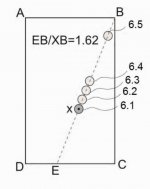
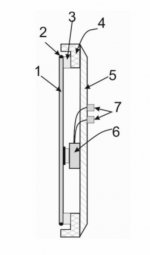
Best, of course, is to read the whole patent, maybe using Google translate. From this patent came their first Mescalito HiFi speaker, most probably. Their videos are short, showing mostly how they work, not how they are made. The patent tells you how they were made, and with a image of the product. Maybe, the inventor must produce a working product to get a Russian patent accepted, not just "I claim, we claim" with other country patents.
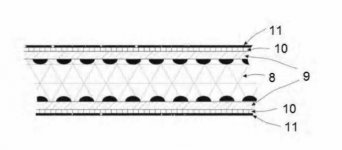
It is a honeycomb panel when finished, and the main sound transferring membrane is paper , on both sides. You'd have to read between the lines to catch some of the inventor's thoughts. Danilo Herger is not a Russian, so you can find the German or US patent somewhere. I'll find the Russian patent that's used to make the Mescalito speakers sometime later, I hope. 🙂


Best, of course, is to read the whole patent, maybe using Google translate. From this patent came their first Mescalito HiFi speaker, most probably. Their videos are short, showing mostly how they work, not how they are made. The patent tells you how they were made, and with a image of the product. Maybe, the inventor must produce a working product to get a Russian patent accepted, not just "I claim, we claim" with other country patents.

It is a honeycomb panel when finished, and the main sound transferring membrane is paper , on both sides. You'd have to read between the lines to catch some of the inventor's thoughts. Danilo Herger is not a Russian, so you can find the German or US patent somewhere. I'll find the Russian patent that's used to make the Mescalito speakers sometime later, I hope. 🙂
Last edited:
Audiofrenzy.Eucy.
I was confused too, it was not what I expected.
I posted this picture when I received them from JohnnoG.
I don't know what he used to cut the panel, but as you see , it does not chip or break .
It is designed to take a heavy pounding and weight.
It is not a lightweight panel, and I would say it has heavy self damping, with minimal self noise.
My low grade eps panels are soft and still produce a good sound, so I think maybe rigidity isn't that important?
I included an old frequency plot but I'm not sure if it was the 6mm or 4mm panel ?
Steve..
This was the 6mm proplex with the round flutes, the next post shows the 4mm square flutes.
Response to 20k.
Steve.
This is the quick recording I made with the low grade EPShkguy6
had a spare half hour, so made this very quick recording of the 1cm eps low grade.
i was holding the phone between the two panels playing fullrange, with no subs .
hope it sounds OK.
steve
Steve.
An excerpt from a Herger Danilo patent of 2021,
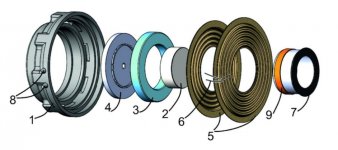
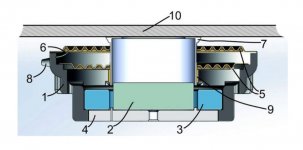
The rest you'd have to read with Google translate.
(Well, if someone here says they reached 20k...when the commercially available exciters can hardly reach 10k, no need of further patents. 🙂)
The proposed technical solution relates to acoustics. It is an electrodynamic drive for the operation of flat-type acoustic systems.
There are a number of industrially produced electrodynamic drives for the operation of flat acoustic systems from different companies: Dayton BST, Monacor, Visatone, Mechakustik, etc. Such loudspeakers are usually designed to operate in the mid-frequency and high-frequency ranges. The lower cutoff frequency of most loudspeakers rarely extends below 100 hertz. Less common are loudspeakers that can provide an operating range in a finished speaker system within 50 Hertz -10 kilohertz. Among industrially manufactured products, there was no such exciter that would provide the full spectrum of audible acoustic radiation (20 Hz-20000 Hz). As a result, industrially produced electrodynamic exciters from many manufacturers are unsuitable for creating a full-range flat-type speaker system. The frequency range of operation of such exciters entails the need to apply various measures to ensure the expansion of the frequency range of the acoustic system: such as the creation of multiband systems in which expansion into the lower and upper region of the boundary frequencies is achieved by using additional acoustic links, including complex systems of acoustic filters, or the use of additional electrodynamic exciters specialized for operation in a narrow acoustic range of the upper or lower register.


The rest you'd have to read with Google translate.
(Well, if someone here says they reached 20k...when the commercially available exciters can hardly reach 10k, no need of further patents. 🙂)
Last edited:
How far is the mic from the panels?This is the quick recording I made with the low grade EPS
Steve.
If you read further down you come to this post with link to photo .Hkguy6
The picture in this post shows the the rug I used to record my headphones recordings .
The last recording was done in exactly the same way , but I held my Samsung a12 phone in my hand instead of resting on the rug.
This way I do not need the low frequency drivers, as the panels produce full range nearfield response.
All other previous recordings were recorded at 1m in front of the panels.
With the low frequency drivers, unless stated otherwise.
The 5mm is a totally different panel when coated in epoxy, it actually sounds good.
It sounded OK with the pva coating but xps has problems with the higher frequencies, the epoxy sorts this out.
But it is no longer a light panel.
I was thinking at some time in the future, to use the scraping method of applying the epoxy to see if I could get a thinner coating ,rather than the roller ,which I felt was too thick and heavy ?
The 2ft proplex panels are the only serious full range panels that I would be happy playing loud rock music without a sub.
They just need more powerful exciters.
Steve.
Steve.
I also just accidentally came across this post, while trying to find pictures of the 10mm low grade EPS with the hf sorted, but still have not found it.I just came across this post of mine on page 170, while looking for wall recordings (side tracked again ) 🤣
And remembered that I never followed up as usual with my findings.
I found that the reflection peak from the close wall, could be sorted by simply turning the panel on its 🙃
It seems obvious now as all the pro panels i have seen are mounted on their sides(tectonic and others).
Basically when the panel is on its side, the close wall sees a fuller frequency response, so reflects the fuller sound back into the room, from both left and right.
When standing upright the wall only sees the reduced frequency response,from the thinner side , it is not an artificial peak, but a drop off of response below the peak, (I hope this makes sense?).
When the panel is on its side you will get a fuller sound spread across the audience at a venue.
And all reflections from side walls will be the same.
In my room the walls are close to the panels, so when the panel is on its side,it reflects the fuller sound back into the room towards me.
Now the peak is firing down into my carpet and up to the ceiling which is further away from the panel.
This one strong reflection from the ceiling will also be absorbed somewhat by the carpet ,hopefully ,it would seem ?
This panel sounded fine when turned on its side,problem solved😁.
I now always mount my small panels on their sides for this reason.
Sorry it took me so long to mention this.
I look forward to any feedback on this and any thoughts.
Steve.
It takes too much time trying to find post🙄.
Steve.
As you can read at the end of the post on panel orientation, I did ask for feedback and thoughts.
No one came back to me so I dropped the subject, and left it there.
Steve.
No one came back to me so I dropped the subject, and left it there.
Steve.
Further to post #8024,
Herger Danilo's invention.

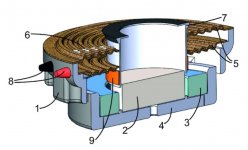
1. Body,
2. Permanent magnet cylindrical shape,
3. Ferrite ring,
4. Steel washer,
5. The system for holding the coil within the magnetic gap in the form of two centering washers of different diameters,
6. Leading an electrical signal to the coil of wire,
7. Ring,
8. Contacts,
9. Cylindrical coil,
10. Sound emitting membrane
For the why and how, you'd have to read his patent. Wonder whether it is to be found in English or German.
Herger Danilo's invention.


1. Body,
2. Permanent magnet cylindrical shape,
3. Ferrite ring,
4. Steel washer,
5. The system for holding the coil within the magnetic gap in the form of two centering washers of different diameters,
6. Leading an electrical signal to the coil of wire,
7. Ring,
8. Contacts,
9. Cylindrical coil,
10. Sound emitting membrane
For the why and how, you'd have to read his patent. Wonder whether it is to be found in English or German.
Most probably, you'd not find Danilo Herger's patents in English or German, even though he is Swiss. I've been searching for quite a while, couldn't find any. Anyway, in that patent registration sphere, there appears to be patents from foreigners, which cannot be found in their own languages. Interesting!
Some images,
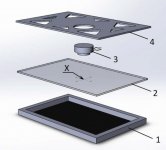
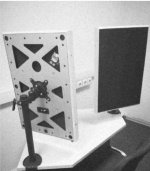
Those, who had watched Mescalito videos might recognise them. 🙂
Some images,


Those, who had watched Mescalito videos might recognise them. 🙂
Last edited:
A bit off-topic, but I think everyone can see why I thought this article would interest this group.
The Unheard Symphony of the Planet
Using a tiny device called a Raspberry Shake, people around the world are tuning in to the earth’s vibrations.
The Unheard Symphony of the Planet
Using a tiny device called a Raspberry Shake, people around the world are tuning in to the earth’s vibrations.
IEEE has a online seminar scheduled that might interest those on this thread...
Title: Electromagnetic Modeling and Design of an Actuator
Date: Thursday, January 26, 2023
Time: 2:00 PM Eastern Standard Time
Duration: 1 hour
Title: Electromagnetic Modeling and Design of an Actuator
Date: Thursday, January 26, 2023
Time: 2:00 PM Eastern Standard Time
Duration: 1 hour
A question arises, can we use ideas depicted in an active patent in a DIY project, or we can only use ideas from an inactive patent?
Chdsl,
You can use any idea of a patent for non commercial uses. An active patent allows the patent assignee's commercial rights for the length of the patent which is currently 20 years if all the fees are paid. Expireeded patents are in the public domain and can be used in commercial products
You can use any idea of a patent for non commercial uses. An active patent allows the patent assignee's commercial rights for the length of the patent which is currently 20 years if all the fees are paid. Expireeded patents are in the public domain and can be used in commercial products
Thanks!Chdsl,
You can use any idea of a patent for non commercial uses. An active patent allows the patent assignee's commercial rights for the length of the patent which is currently 20 years if all the fees are paid. Expireeded patents are in the public domain and can be used in commercial products
I forgot that patents are only for commercial rights.
Further to post #8,030,
Practically everything in that patent can be constructed, except the transducer (3). They must be making the transducer by themselves.
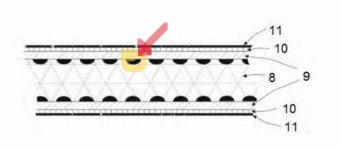
Practically everything in that patent can be constructed, except the transducer (3). They must be making the transducer by themselves.
Also, no idea what might be these black strips.For example, the driver of acoustic vibrations (3) includes one (or several) exciter of acoustic vibrations, containing a housing in which are installed: a magnetic system, a cylindrical coil mounted on a frame, a system for holding the coil within the magnetic gap, and flexible wires for supplying an electrical signal to the coil. At the same time, the magnetic system is made in the form of a permanent magnet of a cylindrical shape, a ferrite ring, in the center of which is installed, the specified magnet of a cylindrical shape and washers fastening them in a single structure, a cylindrical coil mounted on a frame is located above the cylindrical magnet and in the gap between the cylindrical magnet and the ferrite ring, the system for holding the coil within the magnetic gap consists of two centering washers of different diameters fixed at a certain distance from each other, in the form concentrically corrugated discs, with an inner hole attached to a cylindrical coil mounted on a frame, and an outer perimeter to the body, while flexible wires supplying an electrical signal to the coil are sewn into one of the centering washers and soldered to the coil terminals at one end, and to the outer contact group. The frame of the cylindrical coil is attached to the sound emitting membrane (2).

Very good ressources @chdsl . Here are the links to google patents site and some english extracts.
Related to 8021 : RU2743892C1 => the proportions and the exciter position to be investigated in addition to the membrane composition (FEM tools @pway, @Veleric ?)
Related to 8029 : RU2744770C1 => in addition to the claim about the ferrite (non conductive material), the coil seems to be above the traditional air gap which could lead to a lower inductance as usually and so less HF roll off (@BurntCoil for your exciter design?)
Related to 8021 : RU2743892C1 => the proportions and the exciter position to be investigated in addition to the membrane composition (FEM tools @pway, @Veleric ?)
Related to 8029 : RU2744770C1 => in addition to the claim about the ferrite (non conductive material), the coil seems to be above the traditional air gap which could lead to a lower inductance as usually and so less HF roll off (@BurntCoil for your exciter design?)
Hi Steve - I admit to being confused...maybe a scribble sketch or photo will clarifyI also just accidentally came across this post, while trying to find pictures of the 10mm low grade EPS with the hf sorted, but still have not found it.
It takes too much time trying to find post🙄.
Steve.
Eucy
Further to post #8,030,
Practically everything in that patent can be constructed, except the transducer (3). They must be making the transducer by themselves.
Also, no idea what might be these black strips.
View attachment 1126041
My guess is some sort of damping?
- Home
- Loudspeakers
- Full Range
- A Study of DMLs as a Full Range Speaker